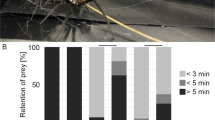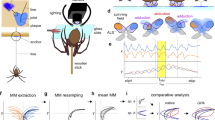Abstract
Entanglements are common in both natural and artificial systems and can result in both beneficial and harmful effects. Most spider webs are static structures held under constant tension and do not tangle. However, many spiders actively load tension into their webs by coiling silk threads that are released to “fire” webs at prey. Here we test whether or not tangling occurs during the rapid release of webs built by the triangle spider Hyptiotes cavatus. We use high-speed videography to examine the release of the spider’s web, looking for signs of tangling both visually on the videos and on acceleration graphs. The spider tenses the web by pulling on a silken anchor line using a leg-over-leg movement, deforming the silk into permanent coils and storing excess slack in a loose bundle between the spider’s legs. This 1–3cm long bundle of coils straightens during the web’s release in as few as 4ms. Though the messy silk coils are pressed closely together, the web’s release is never impeded by catastrophic tangling. This lack of serious tangling is perhaps due to the permanent coils preventing random movement of the silk. The coils also compact the loose silk, preventing interference with the spider’s movement. The ability to coil its anchor line allows H. cavatus to permanently restructure its silk, facilitating its active web-hunting behavior. Our findings broaden our knowledge of silk manipulation by spiders and may give insights into creating tangle-free systems through structural changes.





Similar content being viewed by others
Data availability
Motion-tracking coordinate data used for acceleration analysis are available on Figshare (https://dx.doi.org/10.6084/m9.figshare.7067960)
References
Alexander SLM, Bhamla MS (2020) Ultrafast launch of slingshot spiders using conical silk webs. Curr Biol 30:R928–R929. https://doi.org/10.1016/j.cub.2020.06.076
Bernards MA Jr, Oke I, Heyland A, Fudge DS (2014) Spontaneous unraveling of hagfish slime thread skeins is mediated by a seawater-soluble protein adhesive. J Exp Biol 217:1263–1268
Blackledge TA, Hayashi CY (2006) Unraveling the mechanical properties of composite silk threads spun by cribellate orb-weaving spiders. J Exp Biol 209:3131–3140. https://doi.org/10.1242/jeb.02327
Bradley RA (2012) Common Spiders of North America. University of California Press
Chaudhary G, Ewoldt RH, Thiffeault J-L (2019) Unravelling hagfish slime. J R Soc Interface 16:20180710. https://doi.org/10.1098/rsif.2018.0710
Elettro H, Neukirch S, Vollrath F, Antkowiak A (2016) In-drop capillary spooling of spider capture thread inspires hybrid fibers with mixed solid–liquid mechanical properties. Proc Natl Acad Sci U S A 113:6143–6147. https://doi.org/10.1073/pnas.1602451113
Goriely A (2005) Knotted umbilical cords. In: Physical and numerical models in knot theory. World Scientific, pp 109–126
Han SI, Astley HC, Maksuta DD, Blackledge TA (2019) External power amplification drives prey capture in a spider web. Proc Natl Acad Sci U S A. 116:12060–12065. https://doi.org/10.1073/pnas.1821419116
Mallam AL, Morris ER, Jackson SE (2008) Exploring knotting mechanisms in protein folding. Proc Natl Acad Sci U S A 105:18740–18745. https://doi.org/10.1073/pnas.0806697105
Martini FH (1998) The ecology of hagfishes. In: Jørgensen JM, Lomholt JP, Weber RE, Malte H (eds) The biology of hagfishes. Springer, Netherlands, Dordrecht, pp 57–77
McCook HC (1881) The snare of the ray spider (Epeira radiosa), a new form of orb-web. Pro Acad Nat Sci Phila 33:163–175
Michalik P, Piorkowski D, Blackledge TA, Ramírez MJ (2019) Functional trade-offs in cribellate silk mediated by spinning behavior. Sci Rep 9:9092
Orlandini E, Marenduzzo D, Michieletto D (2019) Synergy of topoisomerase and structural-maintenance-of-chromosomes proteins creates a universal pathway to simplify genome topology. Proc Natl Acad Sci U S A 116:8149–8154. https://doi.org/10.1073/pnas.1815394116
Piorkowski D, Blackledge TA, Liao C-P, et al (2020) Uncoiling springs promote mechanical functionality of spider cribellate silk. J Exp Biol 223.: https://doi.org/10.1242/jeb.215269
Stasiak A, Katritch V, Bednar J et al (1996) Electrophoretic mobility of DNA knots. Nature 384:122–122. https://doi.org/10.1038/384122a0
Strahan R (1963) The behaviour of myxinoids. Acta Zool 44:73–102. https://doi.org/10.1111/j.1463-6395.1963.tb00402.x
Vollrath F (2006) Spider silk: thousands of nano-filaments and dollops of sticky glue. Curr Biol 16:R925-7. https://doi.org/10.1016/j.cub.2006.09.050
Zintzen V, Roberts CD, Anderson MJ et al (2011) Hagfish predatory behaviour and slime defence mechanism. Sci Rep 1:131. https://doi.org/10.1038/srep00131
Acknowledgements
We thank the Summit County Metro Parks for allowing us to collect Hyptiotes cavatus from their parks.
Funding
This research was funded by the National Science Foundation (IOS-1656645).
Author information
Authors and Affiliations
Contributions
S.I.H and T.A.B designed the experiments, S.I.H performed the experiments and analyzed the data, K.Z.H performed the SEM, S.I.H and T.A.B wrote the first draft and all authors approved the final version.
Corresponding author
Ethics declarations
Competing interests
The authors declare no competing interests.
Additional information
Communicated by: Matjaž Gregorič
Publisher's Note
Springer Nature remains neutral with regard to jurisdictional claims in published maps and institutional affiliations.
Rights and permissions
About this article
Cite this article
Han, S.I., Htut, K.Z. & Blackledge, T.A. Permanent deformation of triangle weaver silk enables ultrafast tangle-free release of spider webs. Sci Nat 108, 60 (2021). https://doi.org/10.1007/s00114-021-01769-3
Received:
Revised:
Accepted:
Published:
DOI: https://doi.org/10.1007/s00114-021-01769-3




